Learn by Example - Food Ordering Demo
The Permit MCP server enables AI-powered applications to make real-world access decisions that require human oversight. This project demonstrates how to:
- Use natural language access control via an LLM (Gemini)
- Implement ReBAC (Relationship-Based Access Control) with Permit.io
- Build and extend a real-world MCP server using Python and FastAPI
- Design a command-line client that interacts with AI tools and secure APIs in real time
If you're new to Permit.io’s Access Request MCP, we recommend starting with the following:
- Access Request MCP Overview: Explains the human-in-the-loop pattern and how the MCP architecture enables it.
- Permit MCP Technical Guide: Full installation and configuration reference for deploying and customizing the MCP server.
In this tutorial, you’ll build a fully functional food-ordering system that uses Gemini, FastAPI, and the Permit MCP server to enforce context-aware, human-reviewed access control flows.
Project Overview
This demo brings the Permit Access Request MCP to life through a real-world scenario: a family food ordering system powered by AI, fine-grained policies, and human approvals.
The core idea is simple:
- Children can view a list of restaurants and dishes.
- When a child tries to:
- Access a restricted restaurant → An access request is generated.
- Order a premium dish → An operation approval request is created.
- Parents (who hold elevated roles in Permit) can review and approve/deny these requests.
Once approved, children can proceed with the order.
Tech Stack
This system demonstrates how the Permit MCP server, when combined with an LLM and role-based data modeling, enables secure human-in-the-loop (HITL) access flows for sensitive actions.
| Component | Description |
|---|---|
| LLM (Gemini) | Parses natural language, invokes tools (like order_dish), and asks for user approval when needed |
| Permit.io + ReBAC | Manages fine-grained roles and permission logic |
| MCP Server | Interfaces between the LLM and Permit — creating requests, approving actions, and fetching resource data |
| FastAPI Backend | Hosts the LLM environment securely and exposes a WebSocket for live interaction |
| CLI Client | A terminal-based app for login, chat, and seeing approvals in action |
Project Setup
In this section, we’ll set up the project environment by cloning the MCP demo repository, installing the required tools, and preparing the Python virtual environment.
Clone the MCP Server Repository
Clone the repository and change directory:
git clone https://github.com/permitio/permit-mcp
cd permit-mcp
You’ll find the entire implementation of this demo inside this repo — including the base server, backend, and CLI app.
Install Project Dependencies
Install the MCP project in editable mode to pull in all required dependencies:
uv pip install -e .
fastapi,mcp,permit-sdk, andpython-dotenv- CLI utilities like
httpx,websockets, andrich - Security and auth helpers (
bcrypt,python-jose) - Database helpers (
aiosqlite)
No need to install these manually — the editable install covers everything.
Permit.io Policy Setup
Before running the server, we need to define the access control structure in the Permit.io dashboard. This includes:
- Creating the resource model for restaurants
- Defining ReBAC roles and policies
- Setting up Permit Elements to manage access and approvals
These elements are used both by the backend and the MCP server to handle requests and enforce permissions.
Create a ReBAC Resource for Restaurants
- In your Permit.io Dashboard, go to Policy > Resources
- Click “Create a Resource”
- Fill in the details:
- Name:
restaurants - Roles:
parent,child-can-view
- Name:
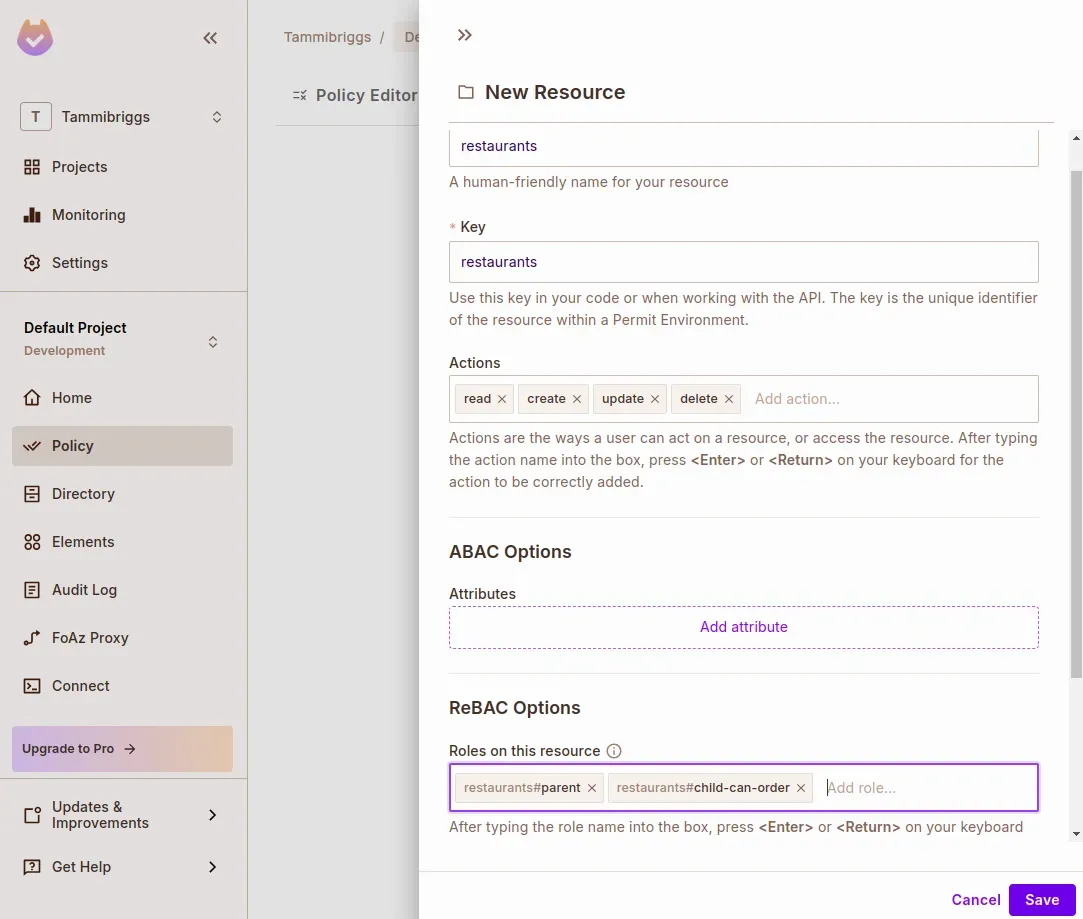
- In the Policy Editor tab, assign permissions:
Role Permissions parentcreate,read,update,deletechild-can-viewread
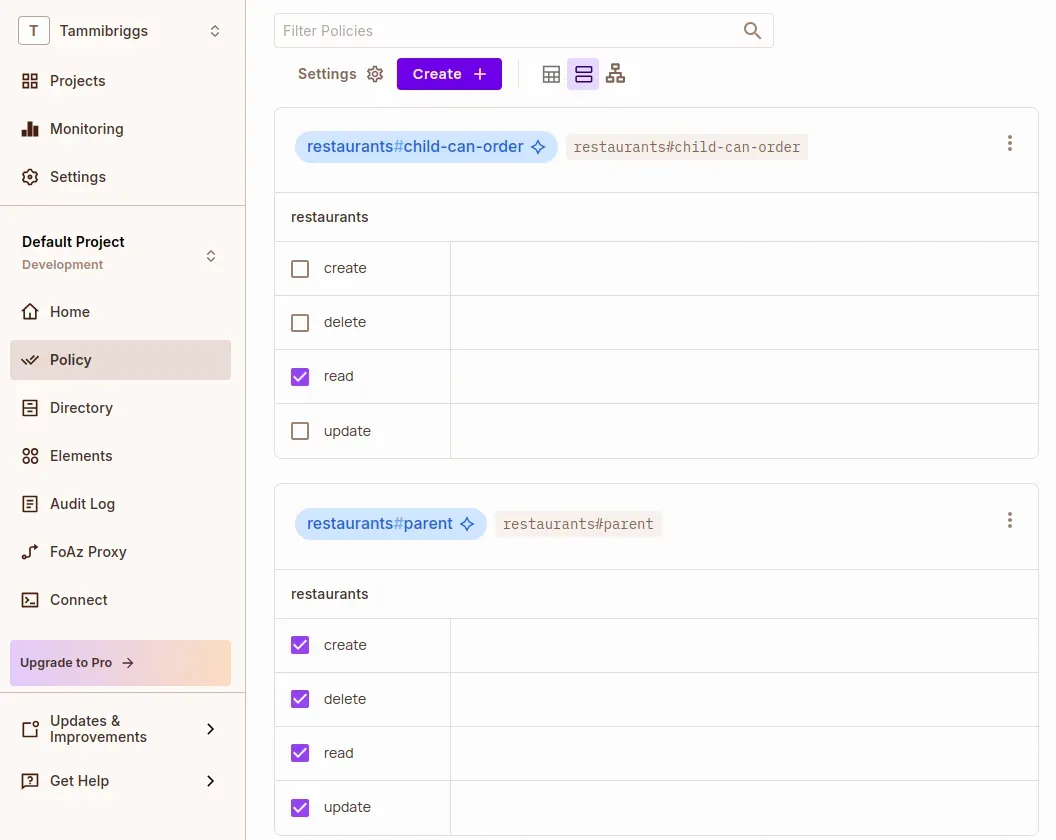
This ReBAC setup ensures children can only access restaurants and menus once granted the child-can-view role.
Create Permit Elements
Permit Elements are embeddable or API-accessible components that handle common access request flows.

- Create a User Management Element for restaurant access requests with the following config:
- Name:
Restaurant Requests - Resource Type:
restaurants - Permission Level Role:
parent - Assignable Roles:
child-can-view
- Name:
This element allows parent users to approve or deny access requests made by children for restaurants.
- Create an Operation Approval Element for dish approvals with the following config:
- Name:
Dish approval - Resource Type:
restaurants
- Name:
This element allows users to request approval for specific operations, like ordering a restricted dish.
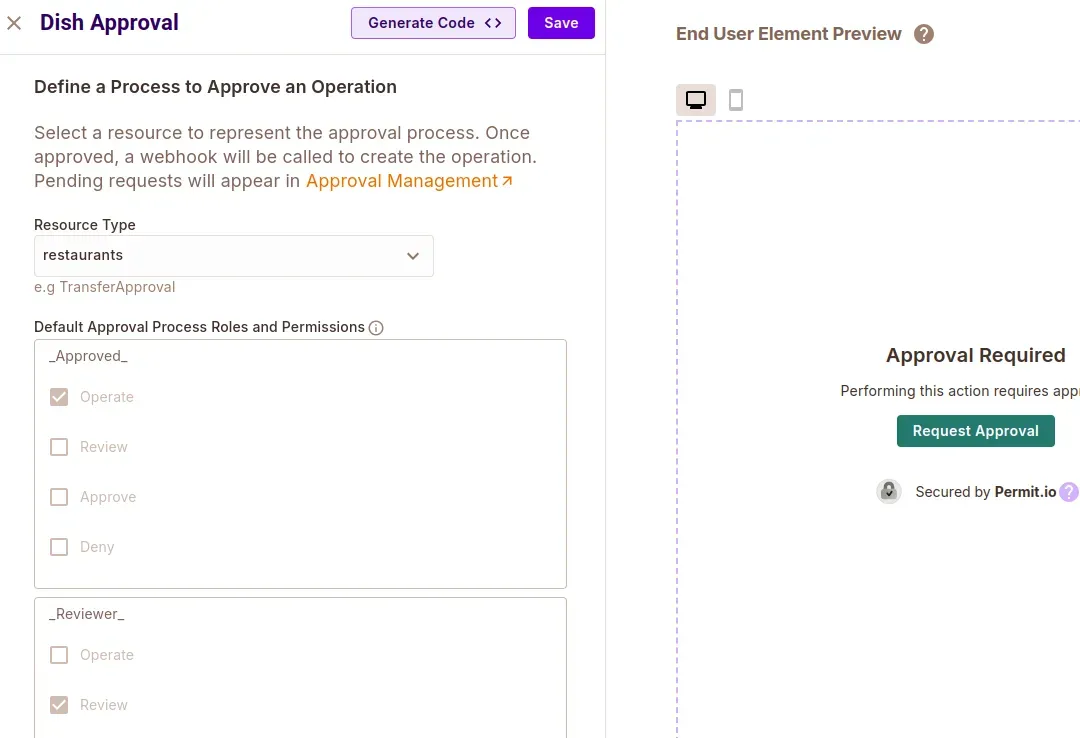
- Create an Approval Management Element for one-time operation requests with the following config:
- Name:
Dish requests
- Name:
This element is used by reviewers (e.g. parents) to approve or deny one-time operation requests, such as premium dish orders.
Save the ELEMENT_CONFIG_ID (e.g. restaurant-requests, dish-requests) for your .env file.

Gather Your Project Configuration
- Head to Project Settings in the Permit dashboard and collect:
PROJECT_ID,ENV_ID,PERMIT_API_KEY,PERMIT_PDP_URL
- Use these values in your
.envfile
Add Test Users & Resource Instances
- Navigate to Directory > Instances
- Click Add Instance
- Resource Type: restaurants
- Instance Key:
*pizza-palace* - Tenant: Default Tenant (or your working tenant)
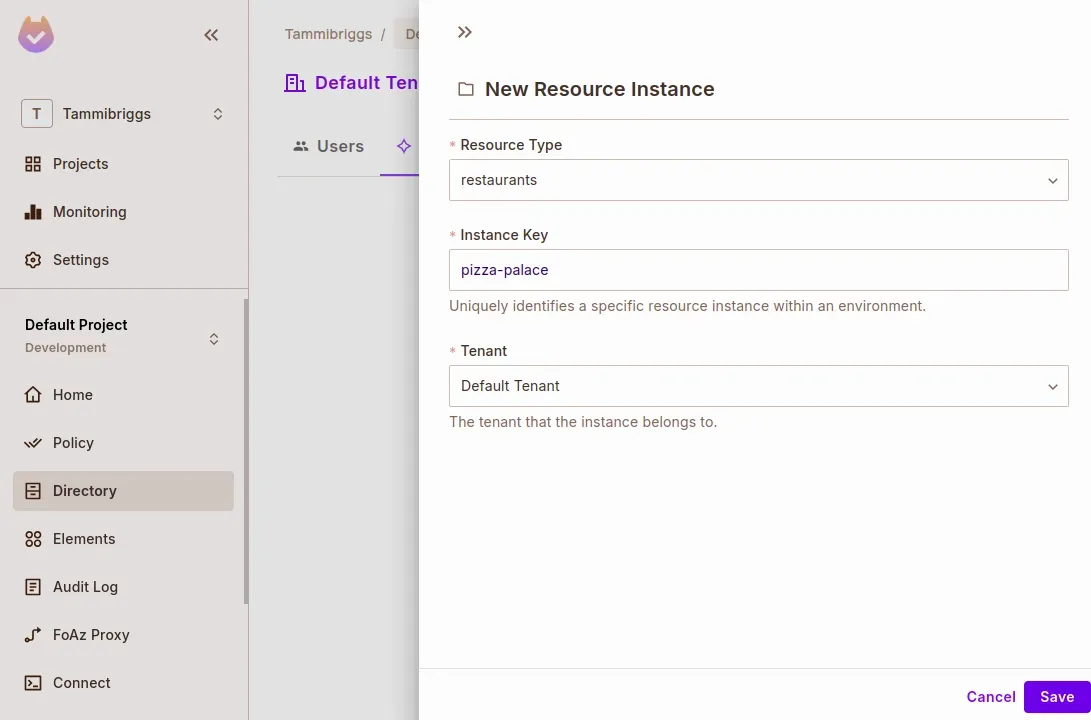
- Switch to the Users tab
- Click Add User
- Key:
joe - Instance Access:
restaurants:pizza-palace#parent
- Key:
- Click Save
- Create another user with the key
henry, but don’t assign a role.
Once everything is configured, we’re ready to clone the MCP server and connect your policies to a working agent.
MCP Server Configuration
Now that your Permit policies are ready, it’s time to configure and launch the MCP server.
For a detailed step-by-step guide on how to do that, please refer to the MCP Server Configuration page.
Once the server is running, tools like create_access_request, approve_access_request, and list_resource_instances become available to your AI agent (Claude, Gemini, etc.).
The server talks to Permit.io’s PDP and Elements APIs to evaluate access rules and process approvals.
Custom MCP Tools
The Permit MCP server includes out-of-the-box tools for access and approval flows, but for real-world use cases, you often need to extend it with domain-specific logic.
In this section, you’ll add two custom tools for the food ordering use case:
list_dishes: Show available meals at a restaurantorder_dish: Place a food order (with access/approval logic)
These tools will integrate with your SQLite database and use permit.check() to enforce permissions dynamically based on ReBAC roles and operation approvals.
Extend the MCP Server with food_ordering_mcp.py
- In your repo root, create a new file:
touch food_ordering_mcp.py
This will be your custom MCP server entry point. It will:
- Initialize Permit
- Connect to your SQLite database
- Register all default Permit tools
- Add your own domain-specific tools
- Set up imports, environment, and MCP server logic
from typing import List, Tuple
import aiosqlite
import sqlite3
import os
import sys
from dotenv import load_dotenv
from mcp.server.fastmcp import FastMCP
from src.permit_mcp.server import PermitServer
from mcp.server.fastmcp.exceptions import ToolError
from permit import Permit
# Load env variables
load_dotenv()
TENANT = os.getenv("TENANT")
DB_NAME = sys.argv[1] if len(sys.argv) > 1 else "test.db"
permit = Permit(
pdp=os.getenv("PERMIT_PDP_URL"),
token=os.getenv("PERMIT_API_KEY"),
)
conn = sqlite3.connect(DB_NAME)
cursor = conn.cursor()
# Initialize MCP
mcp = FastMCP("family_food_ordering_system")
permit_server = PermitServer(mcp) # Register default tools
Add list_dishes Tool
This function allows users to see meals at a given restaurant if they have access:
@mcp.tool()
async def list_dishes(user_id: str, restaurant_id: str) -> List[Tuple[str, float]]:
permitted = await permit.check(user_id, 'read', f"restaurants:{restaurant_id}")
if not permitted:
raise ToolError("Access denied. You are not permitted to view dishes.")
async with aiosqlite.connect(DB_NAME) as db:
query = "SELECT name, price FROM dishes WHERE restaurant_id = ?"
cursor = await db.execute(query, (restaurant_id,))
dishes = await cursor.fetchall()
await cursor.close()
return dishes
Add order_dish Tool with ReBAC and Price Limit Logic
- Checks dish existence
- Validates ReBAC access to restaurant
- Enforces a price limit for children
- Removes temporary
_Approved_role after success
@mcp.tool()
async def order_dish(user_id: str, restaurant_id: str, dish_name: str) -> str:
MAX_ALLOWED_DISH_PRICE = 10 # dollars
async with aiosqlite.connect(DB_NAME) as db:
dish_cursor = await db.execute(
"SELECT price FROM dishes WHERE name = ? AND restaurant_id = ?",
(dish_name, restaurant_id),
)
dish = await dish_cursor.fetchone()
await dish_cursor.close()
if dish is None:
raise ToolError(f"Dish '{dish_name}' not found.")
user_cursor = await db.execute("SELECT role FROM users WHERE id = ?", (user_id,))
user = await user_cursor.fetchone()
await user_cursor.close()
if user is None:
raise ToolError(f"User '{user_id}' not found.")
permitted_restaurant = await permit.check(user_id, "read", f"restaurants:{restaurant_id}")
if not permitted_restaurant:
raise ToolError("You are not allowed to order from this restaurant.")
permitted_dish = await permit.check(user_id, "operate", f"restaurants:{restaurant_id}")
if user[0] == "child" and dish[0] > MAX_ALLOWED_DISH_PRICE and not permitted_dish:
raise ToolError(
f"This dish costs ${dish[0]:.2f}. Approval required for expensive dishes."
)
if permitted_dish:
await permit.api.users.unassign_role({
"user": user_id,
"role": "_Approved_",
"resource_instance": f"restaurants:{restaurant_id}",
"tenant": TENANT
})
return f"✅ Order successfully placed for {dish_name}!"
Run the Server with Your Custom Tools
To launch your custom server:
uv run food_ordering_mcp.py food_ordering.db
This enables your LLM to access both default Permit tools and your extended ones (list_dishes, order_dish) in real time.
Creating a LangGraph + LangChain MCP Client
Now that the Permit MCP server is up and running, we’ll build an AI agent client that can interact with it. This client will:
- Use a Gemini-powered LLM to decide what actions to takeDynamically invoke MCP tools like
request_access,approve_operation_approval, etc. - Run entirely within a LangGraph workflow
- Pause for human review using
interrupt()(in the next section)
Let’s connect the dots.
Install Required Dependencies
Inside your MCP project directory, install the necessary packages:
uv add langchain-mcp-adapters langgraph langchain-google-genai
This gives you:
langchain-mcp-adapters: Converts Permit MCP tools into LangGraph-compatible toolslanggraph: For orchestrating graph-based workflowslangchain-google-genai: For interacting with Gemini 2.0 Flash
Add a Google API Key
Get an API key from Google AI Studio and add it to your .env file:
GOOGLE_API_KEY=your-key-here
Build the MCP Client
Create a file named client.py in your project root. We’ll break this file down into logical blocks:
- Imports and Setup:
Start by importing dependencies and loading environment variables:Then, load the environment and set up your Gemini LLM:import os
from typing_extensionsimport TypedDict, Literal, Annotated
from dotenvimport load_dotenv
from langchain_google_genaiimport ChatGoogleGenerativeAI
from langgraph.graphimport StateGraph, START, END
from langgraph.typesimport Command, interrupt
from langgraph.checkpoint.memoryimport MemorySaver
from langgraph.prebuiltimport ToolNode
from mcpimport ClientSession, StdioServerParameters
from mcp.client.stdioimport stdio_client
from langchain_mcp_adapters.toolsimport load_mcp_tools
import asyncio
from langgraph.graph.messageimport add_messagesload_dotenv()
global_llm_with_tools = None
llm = ChatGoogleGenerativeAI(
model="gemini-2.0-flash",
google_api_key=os.getenv('GOOGLE_API_KEY')
) - Configure MCP Server Parameters:
Tell LangGraph how to communicate with the running MCP server:server_params = StdioServerParameters(
command="python",
args=["src/permit_mcp/server.py"],
) - Define Workflow Nodes and the Graph Builder:
Here’s the logic to route between calling the LLM and invoking tools:asyncdefcall_llm(state):
response =await global_llm_with_tools.ainvoke(state["messages"])
return {"messages": [response]}
defroute_after_llm(state) -> Literal[END, "run_tool"]:
return ENDiflen(state["messages"][-1].tool_calls) == 0else "run_tool"
asyncdefsetup_graph(tools):
builder = StateGraph(State)
run_tool = ToolNode(tools)
builder.add_node(call_llm)
builder.add_node('run_tool', run_tool)
builder.add_edge(START, "call_llm")
builder.add_conditional_edges("call_llm", route_after_llm)
builder.add_edge("run_tool", "call_llm")
memory = MemorySaver()
return builder.compile(checkpointer=memory)
In the above code, we have defined an LLM node and its conditional edge, which routes to the run_tool node if there is a tool call in the state's message, or ends the graph. We have also defined a function to set up and compile the graph with an in-memory checkpointer.
Next, add the following line of code to stream response from the graph and add an interactive chat loop, which will run until it’s explicitly exited.
- Stream Output and Handle Chat Input, and an infinite loop for user interaction:
asyncdefstream_responses(graph, config, invokeWith):
asyncfor eventin graph.astream(invokeWith, config, stream_mode='updates'):
for key, valuein event.items():
if key == 'call_llm':
content = value["messages"][-1].content
if content:
print('\\n' + ", ".join(content)
ifisinstance(content,list)else content)
asyncdefchat_loop(graph):
while True:
try:
user_input =input("\\nQuery: ").strip()
if user_inputin ["quit", "exit", "q"]:
print("Goodbye!")
break
sys_m = """
Always provide the resource instance key during tool calls, as the ReBAC authorization model is being used. To obtain the resource instance key, use the list_resource_instances tool to view available resource instances.
Always parse the provided data before displaying it.
If the user has initially provided their ID, use that for subsequent tool calls without asking them again.
"""
invokeWith = {"messages": [
{"role": "user", "content": sys_m + '\\n\\n' + user_input}]}
config = {"configurable": {"thread_id": "1"}}
await stream_responses(graph, config, invokeWith)
except Exceptionas e:
print(f"Error: {e}") - Final Assembly:
Add the main entry point where we will convert the Permit MCP server tool to LangGraph-compatible tools, bind our LLM to the resulting tools, set up the graph, draw it to a file, and fire up the chat loop:async defmain():
asyncwithstdio_client(server_params)as (read, write):
asyncwithClientSession(read, write)as session:
await session.initialize()
tools =await load_mcp_tools(session)
llm_with_tools = llm.bind_tools(tools)
graph =await setup_graph(tools)
global global_llm_with_tools
global_llm_with_tools = llm_with_tools
withopen("workflow_graph.png", "wb")as f:
f.write(graph.get_graph().draw_mermaid_png())
awaitchat_loop(graph)
if __name__ == "__main__":
asyncio.run(main()) - Lastly, Run the Client:
After running, a new image file called workflow_graph.png will be created, which shows the graph.uv run client.py
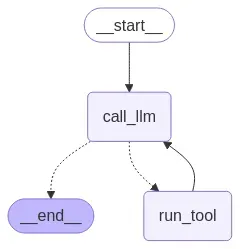
With everything set up, we can now specify queries like this:Query: My user id is henry, request accessto pizza palace with the reason: I am now 18, and the role child-can-order
Query: My user id is joe, list all access requests
Your agent is now able to call MCP tools dynamically.
Adding Human-in-the-Loop with interrupt()
With your LangGraph-powered MCP client up and running, Permit tools can now be invoked automatically.
But what happens when the action is sensitive, like granting access to a restricted resource or approving a high-risk operation?
That’s where LangGraph’s interrupt() becomes useful.
We’ll now add a human approval node to intercept and pause the workflow whenever the agent tries to invoke critical tools like:
approve_access_requestapprove_operation_approval
A human will be asked to manually approve or deny the tool call before the agent proceeds.
Define the Human Review Node
At the top of your client.py file (before setup_graph), add the following function:
asyncdefhuman_review_node(state) -> Command[Literal["call_llm", "run_tool"]]:
"""Handle human review process."""
last_message = state["messages"][-1]
tool_call = last_message.tool_calls[-1]
high_risk_tools = ['approve_access_request', 'approve_operation_approval']
if tool_call["name"]notin high_risk_tools:
return Command(goto="run_tool")
human_review = interrupt({
"question": "Do you approve this tool call? (yes/no)",
"tool_call": tool_call,
})
review_action = human_review["action"]
if review_action == "yes":
return Command(goto="run_tool")
return Command(goto="call_llm", update={"messages": [{
"role": "tool",
"content": f"The user declined your request to execute the {tool_call.get('name', 'Unknown')} tool, with arguments {tool_call.get('args', 'N/A')}",
"name": tool_call["name"],
"tool_call_id": tool_call["id"],
}]})
This node checks whether the tool being called is considered “high risk.” If it is, the graph is interrupted with a prompt asking for human confirmation.
Update Graph Routing
Modify the route_after_llm function so that the tool calls route to the human review node instead of running immediately:
defroute_after_llm(state) -> Literal[END, "human_review_node"]:
"""Route logic after LLM processing."""
return ENDiflen(state["messages"][-1].tool_calls) == 0else "human_review_node"
Wire in the HITL Node
Update the setup_graph function to add the human_review_node as a node in the graph:
async defsetup_graph(tools):
builder =StateGraph(State)
run_tool =ToolNode(tools)
builder.add_node(call_llm)
builder.add_node('run_tool', run_tool)
builder.add_node(human_review_node) # Add the interrupt node here
builder.add_edge(START, "call_llm")
builder.add_conditional_edges("call_llm", route_after_llm)
builder.add_edge("run_tool", "call_llm")
memory =MemorySaver()
return builder.compile(checkpointer=memory)
Handle Human Input During Runtime
Finally, let’s enhance your stream_responses function to detect when the graph is interrupted, prompt for a decision, and resume with human input using *Command(resume={"action": user_input})*.
After running the client, the graph should not look like this:
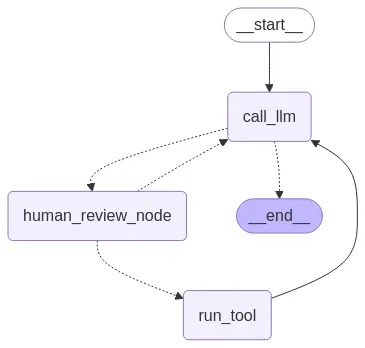
After running the client, your graph diagram will now include a human review node between the LLM and tool execution stages:
This ensures that you remain in control whenever the agent tries to make a decision that could alter permissions or bypass restrictions.
Running the Project
To run the project, first start the FastAPI server using the following command:
fastapi dev server.py
Next, run the CLI using the following command:
uv run client.py
You can log in with the following username and password:
[
{"username": "joe", "password": 'joe_password', "role": "parent"},
{"username": "jane", "password": 'jane_password', "role": "parent"},
{"username": "henry", "password": 'henry_password', "role": "child"},
{"username": "rose", "password": 'rose_password', "role": "child"},
]
Final Thoughts & Resources
In this tutorial, we built a secure, human-aware AI agent using Permit.io’s Access Request MCP, LangGraph, and LangChain MCP Adapters.
Instead of letting the agent operate unchecked, we gave it the power to request access and defer critical decisions to human users, just like a responsible team member would.
We covered:
- How to model permissions and approval flows using Permit Elements and ReBAC
- How to expose those flows via the Permit MCP server
- How to build a LangGraph-powered client that invokes these tools naturally
- And how to insert real-time human-in-the-loop (HITL) checks using
interrupt()
Want to see the full demo in action? Check out the GitHub Repo.
Further Reading:
- Access Request MCP Overview – Understand the concepts behind the MCP model and where HITL workflows are needed.
- Access Request MCP Technical Guide – Learn how to install, configure, and extend the MCP server for other projects.
- LangGraph with Permit.io – Use Permit with LangGraph's
interrupt()function for approval gates.
Got Questions? Join the Permit.io Slack Community